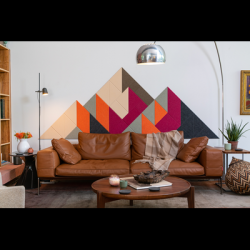Silence, Stops, and Microdynamics
Strategic silence—drum stops, instrument dropouts, or breath spaces—creates contrast. The ear actively responds to changes, so the return of a sound after silence feels more powerful (Rubin, 2016). Microdynamic contrast is a compositional and mixing tool that can make restrained passages feel expansive while keeping measured loudness modest.
Analog Imperfections and Modulation
Wow and flutter, vibrato, subtle detune, and analog modulation create motion within otherwise static notes. These imperfections animate sustained tones and produce harmonic sidebands that help occupy the spectrum. Small amounts of distortion or harmonic saturation increase perceived weight and complexity at low RMS.
Illustrative Examples: Songs That Sound “Full” Without High Volume
Below are concrete examples that show how texture, ambience, layering, and silence contribute to perceived fullness even when peak or average volume is low. Each example includes the mechanism that fills the soundstage.
Texture (Hiss, Vinyl Noise, Background Motion)
| Song / Artist | What Fills the Soundstage | How It Creates Fullness |
|---|---|---|
| Wish You Were Here – Pink Floyd (1975) | Tape hiss, acoustic room resonance | Hiss and room tone prevent silence from collapsing the intro, making the space feel continuous (Milner, 2009). |
| Angels – The xx (2012) | Breathy mic textures, room noise | Ambience around voice and guitar occupies perceptual space at very low volumes. |
| Someone Like You (Live Royal Albert Hall) – Adele (2011) | Hall ambience, audience/hall noise floor | Natural noise floor conveys a real space without compression or boosted peaks. |
Reverb, Echo, and Spatial Effects
| Song / Artist | Spatial Elements | Effect on Fullness |
|---|---|---|
| Running Up That Hill – Kate Bush (1985) | Gated reverb, synth tails | Creates perceived width and sustain without raising peaks (Parsons, 2015). |
| Where the Streets Have No Name – U2 (1987) | Guitar delays, cathedral-like reverb | Echo repeats produce motion and stereo spread. |
| Nude – Radiohead (2007) | Soft vocal and string reverbs | Slow decay spaces give the mix weight at low levels. |
Background Instrumentation & Harmonic Layering
| Song / Artist | Background Elements | Why It Feels Full |
|---|---|---|
| Someday – The Strokes (2001) | Low-level rhythm guitar shimmer | Texture occupies upper mids while staying quietly mixed. |
| Dreams – Fleetwood Mac (1977) | Keyboard pad, ghost harmonies | Midrange pads keep the sound continuous beneath the lead vocal. |
| God Only Knows – The Beach Boys (1966) | Chamber ensemble, stacked harmonies | Soft instrumentation creates broad spectral density (Moore, 2012). |
Backup Vocals & Vocal Stacks
| Song / Artist | Technique | Fullness Mechanism |
|---|---|---|
| Somebody to Love – Queen (1976) | Gospel-style multi-tracking | Dense harmonic stacking increases perceived mass without louder peaks. |
| Gimme Shelter – The Rolling Stones (1969) | Distant, reverbed backing vocal (Merry Clayton) | Adds emotional and spatial depth with low-level presence. |
| Because – The Beatles (1969) | Triple-tracked harmonies | Thick vocal stacks create weight at modest loudness. |
Distortion, Overtones & Modulation
| Song / Artist | Harmonic Element | What It Adds |
|---|---|---|
| The Ocean – Led Zeppelin (1973) | Guitar saturation / amp character | Upper harmonic detail fills the spectrum without raising RMS. |
| Blackstar – David Bowie (2016) | Sax overblow, layered modulation | Overtones create motion at low amplitude. |
| Electric Feel – MGMT (2007) | Warm synth overdrive | Harmonic complexity sustains perceived fullness. |
Silence and Microdynamic Contrast
| Song / Artist | What Happens | Why It Feels Bigger |
|---|---|---|
| Seven Nation Army – The White Stripes (2003) | Hard stops before riff returns | Contrast amplifies the riff’s perceived impact (Rubin, 2016). |
| Smells Like Teen Spirit – Nirvana (1991) | Quiet verses vs. explosive choruses | Low-volume sections make choruses feel enormous without raising peaks. |
| Ain’t No Sunshine – Bill Withers (1971) | Sparse arrangement, intentional breath spaces | Silence frames each element, giving weight to minimal parts. |
Low-Volume Mastering Examples
| Album / Artist | Mastering Signature | How It Fills Space |
|---|---|---|
| Harvest – Neil Young (1972) | Low peaks, strong room tone | Room resonance and soft reverb keep the album warm and spacious (Milner, 2009). |
| Blue – Joni Mitchell (1971) | Low RMS, acoustic harmonic richness | Harmonic detail compensates for low measured amplitude. |
| In Rainbows – Radiohead (2007) | Dynamic mastering, microdynamics | Ambience and microdynamic contrast add perceived complexity. |
How These Examples Reinforce the Core Argument
Across these tracks and albums, loudness is not the primary driver of perceived fullness. Instead, the tracks use a combination of:
- Texture — hiss, pops, room tone;
- Spatial cues — reverb, delay, stereo imaging;
- Harmonic layering — backup vocals, pads, stacked overdubs;
- Motion — vibrato, modulation, echo repeats;
- Contrast — silence, stops, and microdynamic changes.
These elements align with psychoacoustic findings that the brain values spectral density and spatial distribution as much as, or more than, raw amplitude when judging perceived fullness (Moore, 2012). In short: a quiet song can sound huge when the space around its notes is alive.
Conclusion
Volume is a single axis of presence. Thoughtful use of texture, ambience, dynamics, and harmonic content creates immersive mixes that do not rely on loudness. Tape hiss and vinyl pops can act as connective tissue; reverb and delay create perceived space; background layers add spectral mass; silence sharpens impact. Together, these tools let engineers and artists craft recordings that feel alive and full even at modest peak or average levels.
Explore further:
- Join the Discussion in the Forum
- Dive into the Annotated Timeline of Rock History
- Learn More in the Rock Bible
Image Credit: Freepik.com




